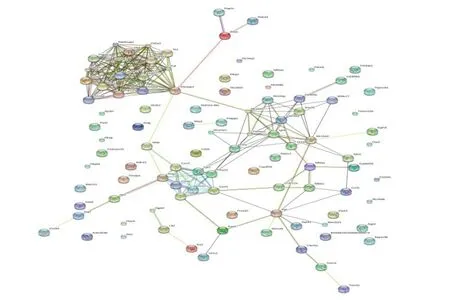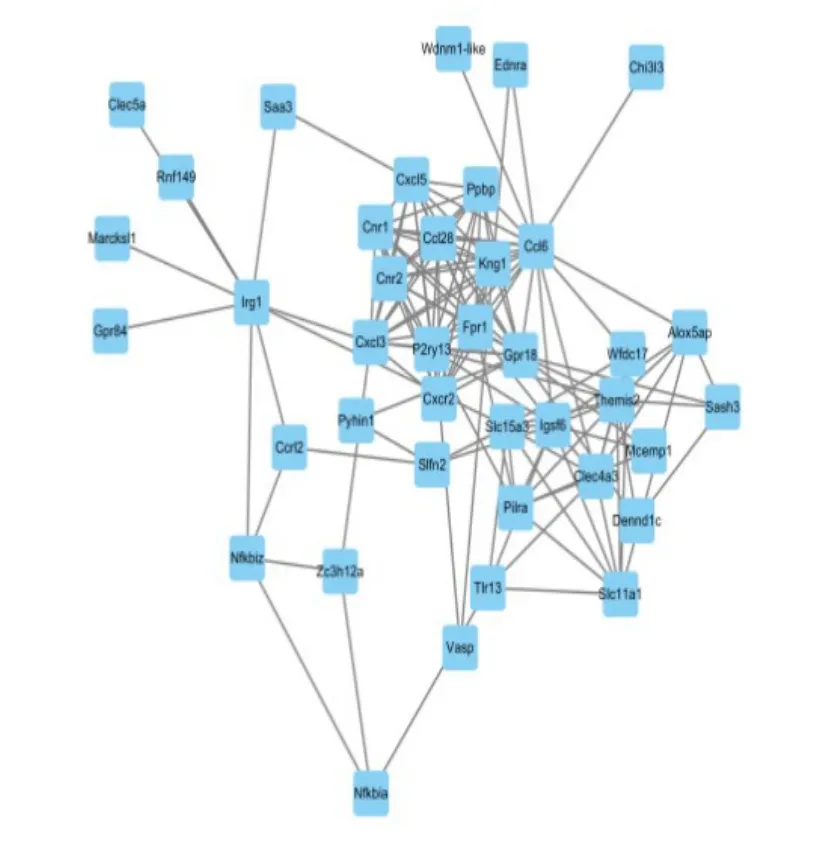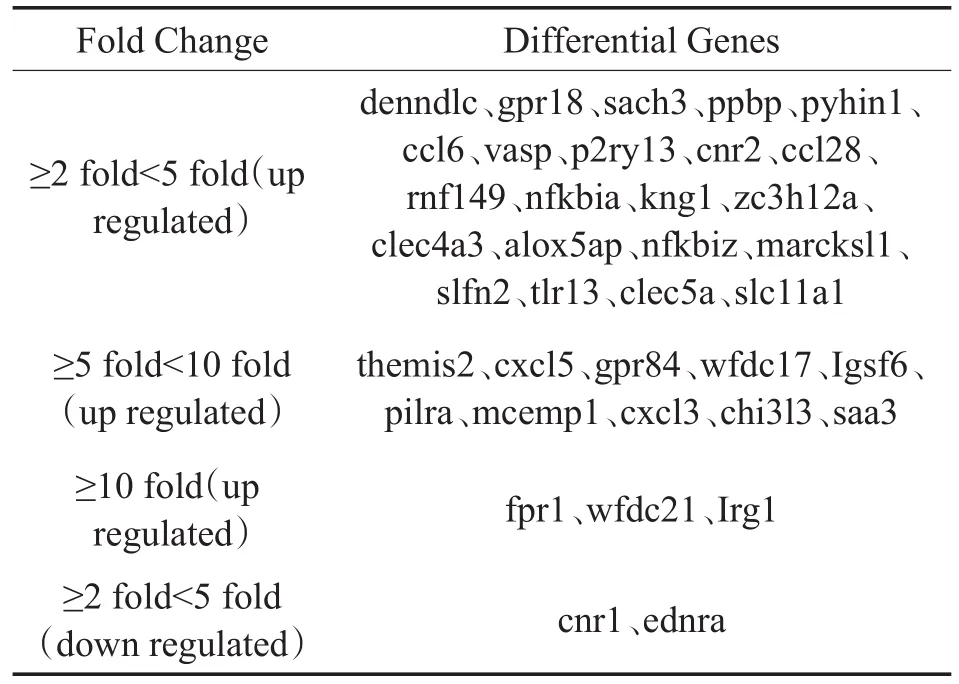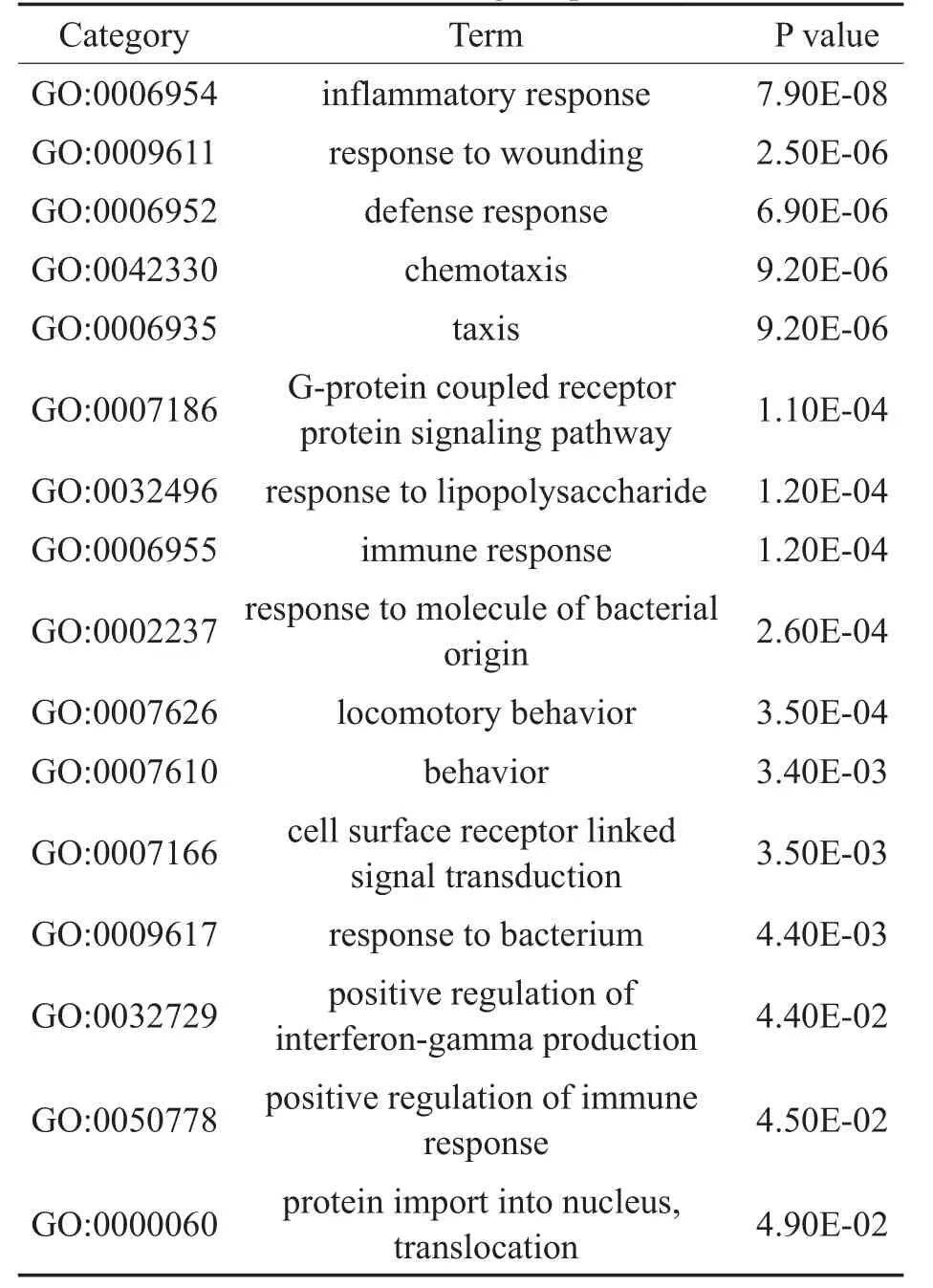小鼠急性未分型流感嗜血杆菌中耳炎差异基因的互作网络特征分析
2017-04-13刘佳丽王维王子萌范芳梅马毓蓉余林何於娟
刘佳丽王维王子萌范芳梅马毓蓉余林何於娟
1重庆医科大学附属第一医院耳鼻咽喉科(重庆400016)2重庆医科大学检验医学院,临床检验诊断学教育部重点实验室(重庆400016)3重庆市第六人民医院(重庆400080)
·基础研究·
小鼠急性未分型流感嗜血杆菌中耳炎差异基因的互作网络特征分析
刘佳丽1王维2,3王子萌2范芳梅2马毓蓉2余林1何於娟2
1重庆医科大学附属第一医院耳鼻咽喉科(重庆400016)2重庆医科大学检验医学院,临床检验诊断学教育部重点实验室(重庆400016)3重庆市第六人民医院(重庆400080)
目的利用基因表达数据库(GEO)查找小鼠中耳炎表达谱基因芯片原始数据,建立中耳炎基因互作网络图。方法从公共数据库GEO中下载小鼠中耳炎相关数据集,采用Affymetrix Expression Console软件和Tran⁃scriptome Analysis Console(TAC)软件筛选差异表达基因,将差异基因导入STRING在线数据库进行分析,绘制差异基因互作网络图,并将互作网络数据导入Cytoscape 3.4.0软件中,筛选网络中心节点,并取其中相对独立、作用较为集中且与炎症基因相关子网络,采用David在线工具对其进行功能注释富集分析。结果共筛选出1166个差异表达基因,其中表达上调793个,表达下调373个,经STRING在线工具筛选后共有459个小鼠中耳炎差异基因编码的蛋白存在相互作用,并得到相应蛋白互作网络,分析其中与炎症相关子网络。结论本研究利用生物信息学技术构建了中耳炎差异基因互作网络,其中的网络中心节点基因,对于中耳炎分子机制研究及靶向治疗具有指导作用。
未分型流感嗜血杆菌;中耳炎;基因芯片;互作网络
Funding:This work was supported by the National Natural Science Foundation of China(csfc81373151),supported by the National Natural Science Foundation of China(cstc2012jjA10014),supported by the Project Foundation of Chongqing Municipal Education Committee(KJ130313),supported by National Key Clinical Specialties Construction Program of china.
Declaration of interest:The authors report no conflict of interest.
中耳炎(Otitis media,OM)是儿童时期最常见的感染性疾病之一[1]。在欧美国家,3岁以下儿童发病率高达80%[2,3]。大部分儿童在一般治疗后痊愈,少数患儿发展为复发性或慢性中耳炎(Chronic otitis media),表现为中耳炎反复发作或迁延不愈,严重时造成进行性听力下降,影响患儿生活质量[4,5,6]。但至今其机制仍不十分明确。已有研究证实中耳炎期间有大量的基因参与了疾病的发生发展过程,如Fbxo11或者Evil基因缺失会导致小鼠自发性中耳炎的发生[7,8],TNF-ɑ、IL-6、IL-1等炎症基因以及Toll样受体也参与了中耳炎的发生[9,10]。目前GEO数据库已有关于中耳炎小鼠的基因芯片研究,经生物信息学分析后筛选出大量差异基因[9]。为进一步了解这些基因产物之间的相互作用及其在中耳炎发生中的作用,我们采用生物信息学方法绘制出差异基因互作网络图,并筛选出其主要网络中心节点,将有助于拓展中耳炎致病机制的研究思路,并为中耳炎治疗提供指导作用。
1 材料与方法
1.1材料
本研究所用数据是小鼠急性中耳炎基因芯片表达谱数据(GSE66141),来源于美国国立生物信息中心(National Center for Biotechnology Informa⁃tion,NCBI)基因表达数据库(Gene Expression Omni⁃bus,GEO),在GEO数据库中以Otitis Media为检索词进行搜索,获得Nick Webster提交的GSE66141芯片数据。本研究中芯片数据采用Affymetrix Mouse Genome 430 2.0 Array平台,并且文章中所用芯片数据共包含30个样本(包含6个时间点的实验组与对照组、以及未处理组均生物学重复两次,小鼠第1天炎症基因表达达到最高峰)[11]。本研究中小鼠急性中耳炎模型所用细菌为未分型流感嗜血杆菌,此细菌是急性中耳炎最常见的致病菌之一。
1.2方法
1.2.1 数据处理及差异基因分析采用Affymetrix Expression Console software和Transcriptome Analy⁃ sis Console(http://www.affymetrix.com/estore/index. jsp)对芯片数据进行统计学分析。将GSE66141原始数据导入Affymetrix Expression Console软件,采用单因素方差分析(one-way Between-Subject ANO⁃VA),将样本数据(GSE66141芯片数据取第1天时间点)按照中耳炎组、生理盐水组进行差异比较,对数据信息进行有效过滤,从而筛选差异基因,筛选条件为:Fold Change<-2 or Fold Change>2,P<0.05。
1.2.2中耳炎差异基因互作网络分析STRING蛋白质相互作用关系数据库能通过基因间的基因组相关性来预测其编码蛋白质之间的相互关系,是目前最大的且应用最广泛的蛋白质数据库之一。将筛选出的1166个中耳炎差异基因(上调基因793个,下调基因373个)导入STRING(http://string-db.org)生物信息在线工具,分析差异基因所编码蛋白之间相互作用,并在线绘制差异基因所编码蛋白互作网络图。
1.2.3 挖掘互作网络中心节点Cytoscape软件是一个开放源码的生物信息分析软件,可用于构建可视化的分子交互作用网络,并可将已有基因表达信息整合进此网络中,观察分子之间如蛋白质与蛋白质间的关联性。将上述STRING在线工具所分析差异基因互作网络数据导入Cytoscape 3.4.0软件,进一步对互作网络进行可视化分析,寻找网络中心节点,并选取其中相对独立、作用较为集中且与炎症相关的子网络绘图,同时将子网络所包含蛋白在pubmed中进行文献检索来验证分析中耳炎发展过程中可能涉及的分子基础。
1.2.4 炎症相关子网络功能注释富集分析和通路分析DAVID生物学信息注释数据库可为大量基因或蛋白提供详细的生物学注释信息。将所筛选炎症相关子网络所涉及基因上传DAVID(https://da⁃vid.ncifcrf.gov/)在线分析软件,对这些差异基因进行GO功能注释富集分析以及生物学信号通路和京都基因与基因组百科全书分析,以便阐述子网络中基因所包含生物学意义。
2 结果
2.1中耳炎差异基因互作网络将从GEO数据库获取的中耳炎基因芯片原始数据用生物信息
学方法分析后得到1166个差异基因,经STRING在线工具分析蛋白网络后,共有459个基因编码蛋白存在相互作用,并构成复杂基因互作网络(图1),并且由图可以观察到网络中心节点不仅与周边节点之间存在相互作用,还与其他中心节点之间存在相互作用。

图1 急性中耳炎差异基因互作网络图Fig.1 Interaction network of the diffetentially expressed genes in acute otitis media
2.2炎症相关蛋白互作子网络经Cytoscape对网络进行可视化分析,并选取相互作用较为集中且与炎症相关子网络进行分析,选取子网络中心节点蛋白在pubmed中进行文献检索验证后,得到以fpr1(甲酰肽受体1)、cxcr2(趋化因子C-X-C基序受体2)、Irg1(炎症反应基因1)、cxcl5(趋化因子C-X-C基序配体)等为重要节点的子网络(图2),其中包含40个表达异常的蛋白质(表1)。

图2 急性中耳炎炎症相关蛋白互作子网络Fig.2 Interaction subnetwork of inflammation-related protein in acute otitis media

表1 中耳炎炎症相关子网络涉及基因及其在基因芯片中差异倍数Table.1 The genes in infalmmation-related interaction subnetwork and their fold changes by microarray
2.3 子网络功能注释富集分析将上述子网络涉及基因数据导入DAVID在线分析工具,并对GO分类p值取0.05过滤后发现,子网络共涉及16种GO生物学过程(biological process,BP)分类(表2),这些基因主要参与炎症应答、创伤反应、趋化、免疫反应等生物学过程。

表2 子网络功能注释富集分析(生物学过程)Table.2 The function annotation of the interaction subnetwork(biological process)
3 讨论
中耳炎是儿童时期最常见的感染性疾病之一,多种基因均参与其发病过程。但目前对中耳炎研究主要倾向于传统单基因方面,显然已不能满足当前系统生物学研究的需要。而对中耳炎采用高通量表达谱基因芯片检测分析后将获得大量关于中耳炎数据信息,包含大量差异表达基因,此时采用生物信息学方法对获得的大量数据进行过滤,筛选在中耳炎发生过程中起关键作用的基因,对于后续中耳炎研究方向的拓展,以及对阐述中耳炎发生的分子机制具有重要作用。
本研究从GEO数据库获得小鼠中耳炎高通量表达谱芯片原始数据,通过生物信息学方法对芯片数据进行深入挖掘筛选后发现有459个差异基因所编码蛋白存在相互作用,其中与炎症相关子网络包含40种异常表达蛋白质,并广泛参与炎症相关的多种生物学过程。其中在中耳炎中差异显著的三个基因cxcl5、fpr1、Irg1在炎症进程中均发挥着重要作用。提示中耳炎发生发展进程中涉及多种基因的相互作用。
cxcl5基因编码趋化因子C-X-C基序配体5,是一种来源于上皮细胞的中性粒细胞活化肽,由致炎因子刺激产生,可诱导中性粒细胞黏附活性,能在脂多糖诱导的小鼠肺部炎症中诱导中性粒细胞的转运[12,13]。目前已有研究证实cxcl5在流感嗜血杆菌诱导的中耳炎小鼠中耳中表达上调,并且流感嗜血杆菌通过调节NF-kB的核转运来激活Ikkβ和p38 MAPK信号通路,从而使cxcl5在中耳上皮细胞表达上调[14],表明cxcl5确实在中耳炎发展过程中发挥了重要作用。在本研究构建的炎症相关子网络中,我们发现cxcl5基因与saa3、ccl6、ccl28、cxcl3、cx⁃cr2、fpr1、p2ry13、gpr18、cnr1、cnr2、kng1、ppbp基因存在相互作用,并经趋化因子信号通路、细胞因子-细胞因子受体信号通路等参与小鼠中耳炎的发生。
fpr1编码甲酰肽受体1,是一种趋化炎症细胞的功能受体,属于G蛋白偶联受体,在炎症刺激下能促进中性粒细胞对细菌的清除[15,16]。研究显示fpr1可促进中性粒细胞的趋化、产生活性氧、脱颗粒、表达细胞因子并诱导吞噬作用、改变细胞表面标志物的表达[17]。在肺炎链球菌脑膜炎小鼠模型中fpr1的缺乏将导致小鼠炎症加重并增加患病小鼠的死亡率[18]。芯片结果显示fpr1在小鼠中耳炎中呈高表达,提示fpr1可能参与了中耳炎的发病过程。在本研究的子网络中,fpr1基因与cxcl5、cx⁃cl3、ccl6、ccl28、cxcr2、cnr1、cnr2、ppbp、kng1、p2ry13、Igsf6、pilra基因存在相互作用,并经趋化因子信号通路、细胞因子-细胞因子受体信号通路参与小鼠中耳炎发生。
Irg1编码免疫应答基因1,由巨噬细胞产生,是重要的免疫调控因子,脂多糖可诱导其产生,并通过酪氨酸激酶磷酸化及PKC激酶途径发挥作用。有研究证实Irg1的存在可增强巨噬细胞的活性,通过抑制Irg1的转录后可在细菌感染过程中通过降低衣康酸在巨噬细胞的水平来降低其抗菌活性[19]。有研究发现阻断巨噬细胞移动抑制因子后,可减轻小鼠急性中耳炎炎症,并改善小鼠听力[20],表明巨噬细胞的功能可能与中耳炎病程相关。因此,Irg1作为巨噬细胞的产物,并参与调节其吞噬活性,我们推测其可能参与了中耳炎疾病进程,值得进一步深入研究。本研究构建的蛋白质网络中,Irg1基因与saa3、clec5a、rnf149、marcks1、gpr84、nfkbiz、ccrl2、cxcl3、slc15a3基因存在相互作用,经趋化因子信号通路,细胞因子-细胞因子信号通路参与小鼠中耳炎发病过程。
综上,我们认为中耳炎的发生是涉及多种基因水平变化并相互作用的一个复杂过程,并构成了复杂基因网络,其中与炎症相关子网络主要涉及cx⁃cl5、fpr1、Irg1等基因的作用,并广泛参与如炎症应答、趋化、G蛋白偶联受体信号通路等多种炎症相关生物学进程。本研究获得的中耳炎差异基因互作网络图不仅为中耳炎研究方向的扩展提供新思路,对于中耳炎发病机制的阐述以及分子靶向治疗的研究也具有较好的提示作用。
1 谷丽,郭其云,狄国华等.儿童分泌性中耳炎手术治疗后生活质量的评估[J].中华耳科学杂志,2016,14(3):396-399. Gu L,Guo QY,Di GH,et al.Assessment on the quality 0f life for children with secretory otitis media after tympanostomy tube Com⁃bined adenoidectomy[J].Chinese Journal of Otology,2016,14(3): 396-399.
2 Rupa V,Isaac R,Rebekah G,et al.Association of Streptococcus pneumoniae nasopharyngeal colonization and other risk factors with acute otitis media in an unvaccinated Indian birth cohort[J]. Epidemiology and infection,2016,144(10):2191-2199.
3 Worrall G.Acute otitis media[J].Canadian Family Physician, 2007,53(12):2147-2148.
4 Marchisio P,Nazzari E,Torretta S,et al.Medical prevention of re⁃current acute otitis media:an updated overview[J].Expert reviewof anti-infective therapy,2014,12(5):611-620.
5 Salah M,Abdel-Aziz M,Al-Farok A,et al.Recurrent acute otitis media in infants:analysis of risk factors[J].International journal of pediatric otorhinolaryngology,2013,77(10):1665-1669.
6 柯嘉,姜立伟,潘滔等.儿童及青少年中耳炎听力损失相关因素分析[J].中华耳科学杂志,2016,14(1):62-66. Ke J,Jiang LW,Pan T,et al.Analysis of factors related to hearing loss in children and adolescents with otitis media[J].Chinese Jour⁃nal of Otology,2016,14(1):62-66.
7 Hardisty-Hughes R E,Tateossian H,Morse S A,et al.A mutation in the F-box gene,Fbxo11,causes otitis media in the Jeff mouse [J].Human molecular genetics,2006,15(22):3273-3279.
8 Parkinson N,Hardisty-Hughes R E,Tateossian H,et al.Mutation at the Evi1 locus in Junbo mice causes susceptibility to otitis me⁃dia[J].PLoS Genet,2006,2(10):1556-1564.
9 Patel J A,Nair S,Revai K,et al.Association of proinflammatory cytokine gene polymorphisms with susceptibility to otitis media[J]. Pediatrics,2006,118(6):2273-2279.
10 Emonts M,Wiertsema S P,Veenhoven R H,et al.The 4G/4G plas⁃minogen activator inhibitor-1 genotype is associated with fre⁃quent recurrence of acute otitis media[J].Pediatrics,2007,120(2): e317-e323.
11 Hernandez M,Leichtle A,Pak K,et al.The transcriptome of a complete episode of acute otitis media[J].BMC genomics,2015, 16(1):1-16.
12 Charo I F,Ransohoff R M.The many roles of chemokines and che⁃mokine receptors in inflammation[J].New England Journal of Med⁃icine,2006,354(6):610-621.
13 Jeyaseelan S,Manzer R,Young S K,et al.Induction of CXCL5 during inflammation in the rodent lung involves activation of alve⁃ olar epithelium[J].American journal of respiratory cell and molec⁃ular biology,2005,32(6):531-539.
14 Konduru A S,Lee B C,Li J D.CCurcumin suppresses NTHi-in⁃duced CXCL5 expression via inhibition of positive IKKβ pathway and up-regulation of negative MKP-1 pathway[J].Scientific Re⁃ports,2016,6:31695.
15 薛鑫,陈星星,王冠等.甲酰基肽受体1对BV-2细胞迁移的影响及机制的体外研究[J].第三军医大学学报,2016,38(1): 44-49. Xue X,Chen XX,Wang G,et al.Formyl peptide receptor 1 pro⁃motes migration in mouse microglial cell line BV-2[J].Journal of Third Military Medical University,2016,38(1):44-49.
16 Liu M,Chen K,Yoshimura T,et al.Formylpeptide receptors are critical for rapid neutrophil mobilization in host defense against Listeria monocytogenes[J].Scientific reports,2012,2:786.
17 Dorward D A,Lucas C D,Chapman G B,et al.The role of for⁃mylated peptides and formyl peptide receptor 1 in governing neu⁃trophil function during acute inflammation[J].The American jour⁃nal of pathology,2015,185(5):1172-1184.
18 Oldekamp S,Pscheidl S,Kress E,et al.Lack of formyl peptide re⁃ceptor 1 and 2 leads to more severe inflammation and higher mor⁃tality in mice with of pneumococcal meningitis[J].Immunology, 2014,143(3):447-461.
19 Michelucci A,Cordes T,Ghelfi J,et al.Immune-responsive gene 1 protein links metabolism to immunity by catalyzing itaconic ac⁃id production[J].Proceedings of the National Academy of Scienc⁃es,2013,110(19):7820-7825.
20 Zhang J,Xu M,Zheng Q,et al.Blocking macrophage migration in⁃hibitory factor activity alleviates mouse acute otitis media in vivo [J].Immunology letters,2014,162(1):101-108.
Interaction network analysis of differentially expressed genes in mice with unclassified haemophilus influenzae induced otitis media
Liu Jiali1,Wang Wei2,3,Wang Zimeng2,Jin Chunfang2,Fan Fangmei2,Ma Yurong2,Yu Lin1,He Yujuan2
1 Department of Otorhinolaryngology,The First Affiliated Hospital of Chongqing Medical University,Chongqing 400016 2 College of Laboratory Medicine,Chongqing Medical University,Chongqing 400016,China 3 College The Sxith People’s Hospital of Chongqing City,Chongqing 400080,China Corresponding author:He Yujuan Email:yjhemail@126.com
Objective Using bioinformatics methods to analyze gene expression microarray of otitis media in order to establish a protein interaction network.Methods The microarray data sets of otitis media from the mouse were downloaded from the public gene expression database Gene Expression Ombibus(GEO).The differentially expressed genes were screened by Affymetrix Expression Console software and Transcriptome Analysis Console(TAC)software.Then the differentially expressed genes were introduced into the STRING online database for analysis,and the interaction network was established.The interaction data was subsequently introduced into the Cytoscape 3.4.0 software,and the network center nodes were screened,and those relatively independent sub-networks associated with the inflammation genes were selected.David online tools were used for functional annotation enrichment analysis of these sub-networks. Results A total of 1166 differentially expressed genes were screened out,including 793 up-regulated and 373 down-regulated.Screened by STRING,interactions of protein products from 459 differentially expressed genes were found,andthe corresponding protein interaction network was obtained.Conclusion In this study,bioinformatics techniques were used to construct the interaction network of the differentially expressed genes for otitis media.The network,especially the center node gene could provide new clues of the molecular mechanism of otitis media,and guide the targeted therapy.
Nontypeable Haemophilus influenzae;Otitis media;Microarray;Interaction network
R764.21
A
1672-2922(2017)01-94-5
2016-09-05审核人:翟所强)
10.3969/j.issn.1672-2922.2017.01.018
国家自然科学基金(csfc81373151)、重庆市自然科学基金(cstc2012jjA10014)、重庆市教委科学技术研究项目(KJ130313)、国家临床重点专科建设项目经费基金资助卫办医政函[2012]649号
刘佳丽,硕士,研究方向:中耳炎发病机制
何於娟,Email:yjhemail@126.com
